 Many nonprofits are understandably worried about the additional financial pressures that may be created by the new Trump administration’s budget priorities. The preliminary budget proposal released in March raises concerns in two major ways:
Many nonprofits are understandably worried about the additional financial pressures that may be created by the new Trump administration’s budget priorities. The preliminary budget proposal released in March raises concerns in two major ways:
- Sharp reductions in federal funding support for nonprofits, particularly in social services and in arts and culture, and
- A huge increase in the standard income tax deduction, combined with reductions in marginal tax rates for wealthy individuals, which will greatly reduce the tax benefits of charitable giving.
And many state governments are also facing the pressure to address budget challenges by cutting funding for schools, social services, and other nonprofit organizations.
Now, financial pressures are nothing new for most nonprofit executives. Those of us around since the 1980s remember the initial concern that many nonprofits had in response to Ronald Reagan’s economic plan, which also included tax and spending cuts that could potentially hurt nonprofits. But economic growth during the 1980s and 1990s led to increases in charitable giving, and some nonprofits actually benefited from the attempt to shift some government responsibilities to private organizations.
And the “Great Recession” a decade ago reduced revenue significantly for many nonprofits, but they made adjustments and weathered the storm.
Managing a Nonprofit in Uncertain Times
The most challenging part of managing a nonprofit in the current environment is the uncertainty about where the government’s policies will come out, and what impact that will have in the end.
So what actions should you take now to ensure that your nonprofit continues to successfully deliver on its mission in the years ahead?
- Make Sure Your Strategic Plan Is Up To Date
It’s more important than ever to be proactive, rather than reactive, and you can’t do this well if you don’t have a clear vision as to where you’re going and how you’re going to get there. A strong strategic plan will help ensure alignment between your mission and the resources needed to deliver on it, and will help you identify potential risks earlier and better manage them. If you wait until the situation becomes desperate, your options for strengthening your organization’s finances may be more limited. And if you do decide to cut programs, a solid plan will help you identify which programs are mission-critical and which are less essential.
- Communicate With And Engage Key Constituencies
Your key constituencies include those you serve with your programs, as well as your funders and your employees and board. In tough times, you may need to ask more of them, and your organization’s success will depend even more than usual on their continued support. So keep them in the loop, and make sure you’re doing as good a job as possible of telling your story. You may decide you need to keep confidential some things about your organization’s operations; but if you’re asking for sacrifices, or for additional funding, people will usually respond better if they feel you’re being open and honest with them. Transparency is key.
- Make Sure Your Mission And Branding Reflect The New Reality
Consider broadening your mission in order to increase fundraising appeal. It may seem counterintuitive, but if you see signs that funding is decreasing – or are concerned that it will – then it may make sense to expand your mission to include areas that complement your existing goals rather than to retrench, if doing so will bring in new donors.
- Don’t Let Fundraising Pressures Distract You From Focusing On Strategic Operational Issues
When revenue falls, it is understandable that your top priority may be to increase focus on funding sources. And that’s important, of course. But when times are tight, it is equally important to make sure your organization is running as efficiently as it can. This may be a great time to explore opportunities for partnering or collaborating with other organizations in order to improve operational efficiency or effectiveness. Are there non-competitive organizations whose constituency overlaps yours? Perhaps you can partner on marketing efforts. Or perhaps there are organizations with which you can share services to reduce expenses.
- Reduce Costs, But In A Smart Way
Before you decide to cut staff or programs, take a hard look at your operations and expenditures to find ways to improve efficiency, for example:- Renegotiate contracts – Many vendors will be willing to lower their price rather than lose your business altogether
- Assess compensation levels to make sure they reflect the current reality. It may be better to reduce salaries or bonuses (or hours) than to completely eliminate positions, especially to avoid the loss of the key employees who you will want to be there when things turn around.
- Pursue New Revenue Streams
Many nonprofits have discovered the value of creating a “social enterprise” program, which leverages the organization’s existing physical assets or brand to create additional revenue. And one of the best things about social enterprise revenue is that it adds a source of unrestricted cash flow that can be used however the organization sees fit. If fundraising from traditional channels declines with the change in federal budget policies, we expect social enterprise will become more essential as a way to ensure nonprofit programs can be funded at the same level.
It’s difficult to predict how the federal budget debate will turn out, and how that will affect the nonprofit community. But by managing your expenses wisely, keeping sight of the long-term mission and strategy, and demonstrating openness to innovation and change, you can ensure that your organization will thrive in the long run, regardless of whatever hurdles you face along the way.
Agree? Disagree? Share your thoughts in the Comments below.

